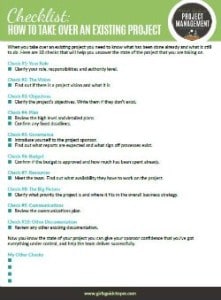HOW TO TAKE OVER AN EXISTING PROJECT [FREE CHECKLIST]
Link -
http://www.girlsguidetopm.com/2016/04/how-to-take-over-an-existing-project

Consider this. You’ve recently taken over a project that has already started. Your handover hasn’t been that great. The previous project manager might have moved on to do something else and you’ve got the project as part of an internal reshuffle of resources. Or they might have left the company.
Either way, you’ve got a team waiting on your direction. The sponsor wants confidence that you’ve got everything in hand. And you’re staring at a system full of project documents and some emails that have been forwarded on.
How can you check what you’ve got and what needs to be done next?
First, don’t panic. Let me guide you through how to assess the state of the project you’ve inherited. We’ve got a lot to get through so here’s what we are going to cover in a little clickable table of contents.
- Why You Need A ‘Take Over A Project’ Checklist
- Check #1: Your Role
- Check #2: The Vision
- Check #3: Objectives
- Check #4: Plan
- Check #5: Governance
- Check #6: Budget
- Check #7: Resources
- Check #8: Big Picture
- Check #9: Communications
- Check #10: Existing Documentation
- Why Are Elements Missing?
- Next Steps
- Further Sources of Help

Get this free printable checklist about how to take over a project from someone else. Scroll to the bottom to download it.
Why You Need A ‘Take Over A Project’ Checklist
Whenever you take on a project that was started by someone else you need to:
- Understand the health of the project
- Ensure that sufficient planning has been completed so that the onward direction is clear.
By ‘health’ I mean what kind of a state the project is in. You won’t know if the risk log is sound and the resource planning sensible until you investigate.
Best case, you’ll find out that the last project manager did a good job and that everything is in order. Worst case, you’ll find out that there are hardly any plans, documents and methods of control over the work. And you’ll conclude that you’ll be terribly busy for the next few weeks.
Either way, you need to know. Here are 10 checks that will help you uncover the state of the project that you are taking on.
Check #1: Your Role
First, establish the authority that the project manager (that’s now you) has on this project.
Is there a programme manager and a programme under which this project fits? If not, what authority has the project charter conferred upon you?
Understanding your roles and responsibilities is a good step and even if this isn’t documented it will help you make sure that all stakeholders are considered and your escalation paths are clear for when there are issues.
Check #2: The Vision
Is there a vision statement that explains the future state that this project is hoping to achieve? It’s fine not to have a detailed plan of how you are going to get there but you should a pretty clear idea of where ‘there’ is.
Action if No: Write one. You probably have a lot more authority than you think to just do this and then pass it by the powers that be.
Check #3: Objectives
Is there clarity around objectives? ‘Yes’ is the right answer, by the way.
‘No’ means there is much more work to do here to understand what the project is trying to achieve. Projects should have objectives that result in clearly defined outputs and benefits.
Action if the answer is No: Ask the project sponsor to hold a workshop on defining this and providing ultimate clarity for everyone. Or if they know it but haven’t documented it, write a paragraph – no need for lengthy meetings if everyone sort of knows but hasn’t seen it on paper.
Check #4: Plan
Is there a high level project plan? It’s probably a few coloured boxes in an Excel spreadsheet saying which month or quarter you are expecting to work on each phase within the project, aligned to the major tranches of work.
The absence of a detailed plan might not be the end of the world.
The only way you’ll know what planning has been done already is if you dig through the archives.
For the objectives you’ve uncovered, you should be able to get a feel for what level of planning is sufficient. You need enough planning in place to be able to structure the work of the people involved and hit any hard targets such as fixed delivery dates.
The only way you’ll know what planning has been done already is if you dig through the archives. Spend time with people talking about their tasks and how they track and manage the work. You might not find a Gantt chart but you might not find the situation is as scary as you first thought either.
Action if the answer is No: Get together with your team and write a high level plan. You can leave the detailed stuff until your review is finished but having something at high level will eventually inform your detailed project planning for the next 6 months.
Check #5: Governance
Is there a governance structure? Who is your project sponsor? What’s the reporting schedule? What are the internal sign off hoops you have to go through? If there aren’t any that would worry me: light bureaucracy is good but someone should be providing some oversight.
Action if the answer is No: My first point of call would be your project sponsor. They should be providing the direction and accountability. For other areas of governance such as reporting and approval levels, talk to your PMO and get these in place.
Check #6: Budget
Is the budget approved? How do you spend it? How much has been spent already?
Action if the answer is No: Back to the PMO or your Finance team. In a push, you can ask vendors to send you copies of contracts and paid invoices. Use the, “I’m new to the project and gosh the filing is in a shocking state! Could you please do me a massive favour and…” approach. This has worked well for me in the past if you can get over the fact you’re asking questions that make you look a bit dim.

Check #7: Resources
What resources are available to the programme, now and in the future? You want to find out the hours each person has available to the project. It’s better to know now if you are going to be short staffed. It will help with planning.
Action: Talk to the PMO again. Or if you don’t have one, the team leaders of the people you have on the team. And the team themselves.
Check #8: Big Picture
Where does the project fit in the overall business strategy? In other words, it could be a lot of money but is it the CEO’s top priority? If not at least you’ll know where you stand when it comes to competing for resources.
Action: You can’t change the priority of the project but if you cannot get a clear answer on where it fits in company priorities that would be a red flag for me. Go back to the PMO, they should be prioritising initiatives. If they don’t do this, or you don’t have an equivalent group that does prioritise work, you should be turning to your manager for clarification.
Check #9: Communications
What communications structure is in place? If this is a transformative project you’ll have a lot of stakeholders at project and (potentially) programme level.
Action if the answer is No: Sort this out as soon as possible. A comms plan is not difficult to pull together and best to get it in place before you get too much further with the programme.
Check #10: Existing Documentation
Review any existing documentation. However you do it, you’ll have to use your best office politics to uncover what has been done and what’s missing.
I found that coming back from maternity leave was an excellent excuse to ask lots of ‘stupid’ questions to ‘remind myself’ of what we were doing and to get back up to speed. You might not have that excuse, but taking over a new project certainly gives you some scope to ‘check’ what the latest is in various areas.
OK, now you know what is there and what is missing.
Why Are Elements Missing?
I would also ask around and find out why none of this stuff has been done. Is it that they don’t have time? Or the skills, experience, interest? The company culture has a lot of influence over what is done and what is ignored not followed up.
It’s important to match what you are trying to do and the standards to which you want to do it to the company culture. If you try to put a very formal project structure in place in a normally informal culture then you won’t get very far.
Next Steps
Now you know where you stand. You know which parts of the project are OK and which look a bit dodgy. You can focus your energy on getting a decent plan, or setting up the governance structure, or dealing with the budget – whatever you think is the most important part to get right, right now.
Involve your team, be transparent in what you are doing and why, and keep your sponsor informed. Above all, never blame the last project manager or the team for the mess you are in now. They were probably doing the best job they could at the time.
If you think that they weren’t, read my Ultimate Guide To Getting People To Take Responsibility At Work.
Good luck! You’ll soon have that new project under control.
Further Sources of Help
If your work so far has uncovered things that concern you, then consider investing some time in a formal healthcheck process. At one end of the scale you’ve got models like Joanne Flinn’s in her book The Success Healthcheck for IT Projects*. This is in-depth and structured and probably quite time consuming, which is a luxury you might not have.
At the other end of the formality scale you’ve got something like Peter Taylor’s Get Fit with The Lazy Project Manager* book which will give you a practical approach to structuring a healthcheck.
* Those are affiliate links. I earn enough from your clicks to buy a coffee every so often, so thank you!










0 comments